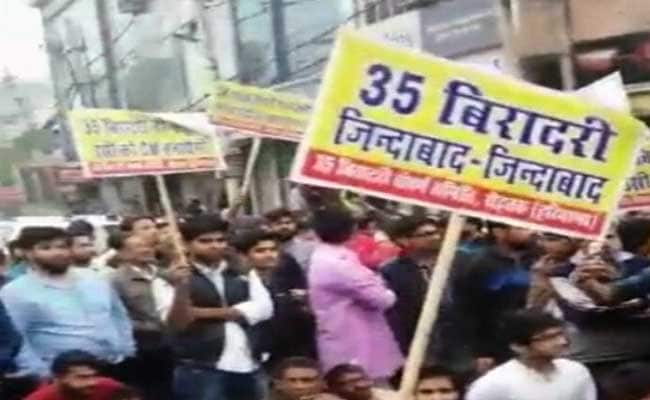In Rohtak's market areas, stores owned by Punjabis and the Saini community were looted and burnt.
Rohtak, Haryana:
As the agitation by Jats seeking reservations heated up in Haryana last week, the rioters' anger took a disturbing turn in the towns of Rohtak and Jhajjar. There were accusations of attacks directed specifically at the shops and homes of other communities.
We were told of one example after another of selected targeting in the market areas in Rohtak where stores owned by Punjabis and the Saini community were looted and burnt, while stores of Jats, right next door, were left untouched.
CCTV footage, accessed by NDTV, shows young men attack a shop in a Punjabi neighbourhood of Rohtak, and help themselves to cellphones, before damaging the shop.
"Branded shops were targeted. The shops which were owned by Punjabis not by Jats. They targeted non-Jat shops," said Sachin Jain, a trader in the neighbourhood.
It is this aspect of the violence, which Haryana's trading communities say suggests that the violence is less do with reservation, more as a chance to settle scores with the non-Jat chief Minister, ML Khattar. The agitation, the say, was an excuse to start a riot.

"Actually they felt bad as for the first time a Punjabi CM was appointed. Why he was appointed? They have this psychological issue. They want to change that," alleged Kamal Nijhawar, another Rohtak resident.
Jat community leaders we met in Rohtak denied this. They say they have nothing against Mr Khattar, but some members of his party have derided the Jat community.
Equally, the mobilisation by the other castes in response to the Jats' aggression - indicative of Haryana's shifting political winds - has only stoked the crisis.
In another video, the 'paintees samaj', a reference to the 35 non-Jat communities who came together during the agitation in Rohtak, are seen holding a rally to deliver a petition, asking for security. This group later clashed with a group of Jat lawyers who were gathered at a prominent traffic intersection in the town. The clash escalated into one of the worst riots Rohtak has seen.
In Jhajjar, the inter-caste rivalry took a fatal turn. On the morning of February 21, angered at the damage to their shops, members of non-Jat communities attacked a dharamshala (a rest house for pilgrims) named after the venerated Jat farmer leader, Sir Chhotu Ram.
On the day we visited it, the building stood gutted and the statue of the leader desecrated.
The Jats retaliated by storming a Saini neighborhood in Jhajhaar's Chaavani mohalla, but went beyond just burning homes. Two men, Krishen Saini and Shyam Lal Singh, were dragged out of their houses and killed.
"It happened in the afternoon" said Bhateri Devi, Shyam Lal's grieving wife. "I don't know who the men were," she said, as her neighbours looked on in anger. For them, it was clear who had committed the murders.
The violence in Haryana may have died down, but the scars will take longer to heal.
Watch more on Truth vs Hype: Politics, Caste, Violence - Haryana's Deadly Cocktail
Saturday 9:30pm, Sunday 7:30pm NDTV 24x7
We were told of one example after another of selected targeting in the market areas in Rohtak where stores owned by Punjabis and the Saini community were looted and burnt, while stores of Jats, right next door, were left untouched.
CCTV footage, accessed by NDTV, shows young men attack a shop in a Punjabi neighbourhood of Rohtak, and help themselves to cellphones, before damaging the shop.
"Branded shops were targeted. The shops which were owned by Punjabis not by Jats. They targeted non-Jat shops," said Sachin Jain, a trader in the neighbourhood.
It is this aspect of the violence, which Haryana's trading communities say suggests that the violence is less do with reservation, more as a chance to settle scores with the non-Jat chief Minister, ML Khattar. The agitation, the say, was an excuse to start a riot.

"Actually they felt bad as for the first time a Punjabi CM was appointed. Why he was appointed? They have this psychological issue. They want to change that," alleged Kamal Nijhawar, another Rohtak resident.
Jat community leaders we met in Rohtak denied this. They say they have nothing against Mr Khattar, but some members of his party have derided the Jat community.
Equally, the mobilisation by the other castes in response to the Jats' aggression - indicative of Haryana's shifting political winds - has only stoked the crisis.
In another video, the 'paintees samaj', a reference to the 35 non-Jat communities who came together during the agitation in Rohtak, are seen holding a rally to deliver a petition, asking for security. This group later clashed with a group of Jat lawyers who were gathered at a prominent traffic intersection in the town. The clash escalated into one of the worst riots Rohtak has seen.
In Jhajjar, the inter-caste rivalry took a fatal turn. On the morning of February 21, angered at the damage to their shops, members of non-Jat communities attacked a dharamshala (a rest house for pilgrims) named after the venerated Jat farmer leader, Sir Chhotu Ram.
On the day we visited it, the building stood gutted and the statue of the leader desecrated.
The Jats retaliated by storming a Saini neighborhood in Jhajhaar's Chaavani mohalla, but went beyond just burning homes. Two men, Krishen Saini and Shyam Lal Singh, were dragged out of their houses and killed.
"It happened in the afternoon" said Bhateri Devi, Shyam Lal's grieving wife. "I don't know who the men were," she said, as her neighbours looked on in anger. For them, it was clear who had committed the murders.
The violence in Haryana may have died down, but the scars will take longer to heal.
Watch more on Truth vs Hype: Politics, Caste, Violence - Haryana's Deadly Cocktail
Saturday 9:30pm, Sunday 7:30pm NDTV 24x7
Track Latest News Live on NDTV.com and get news updates from India and around the world

